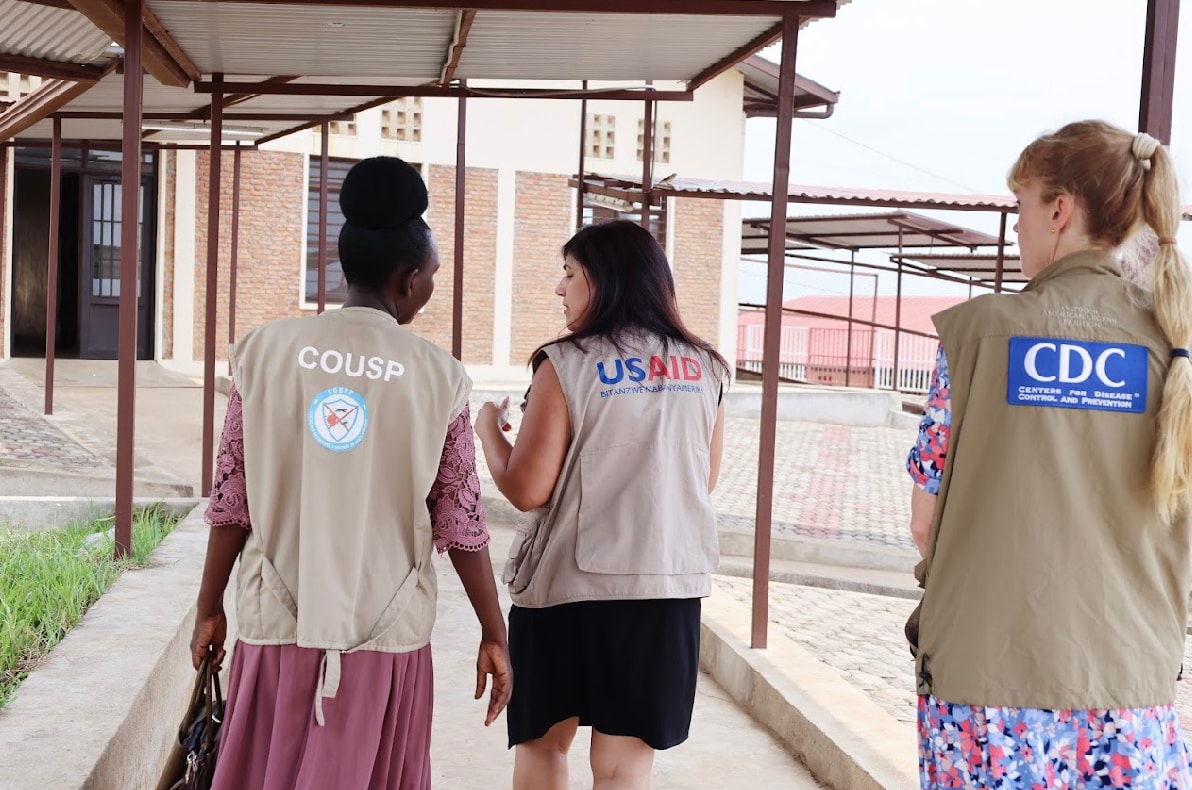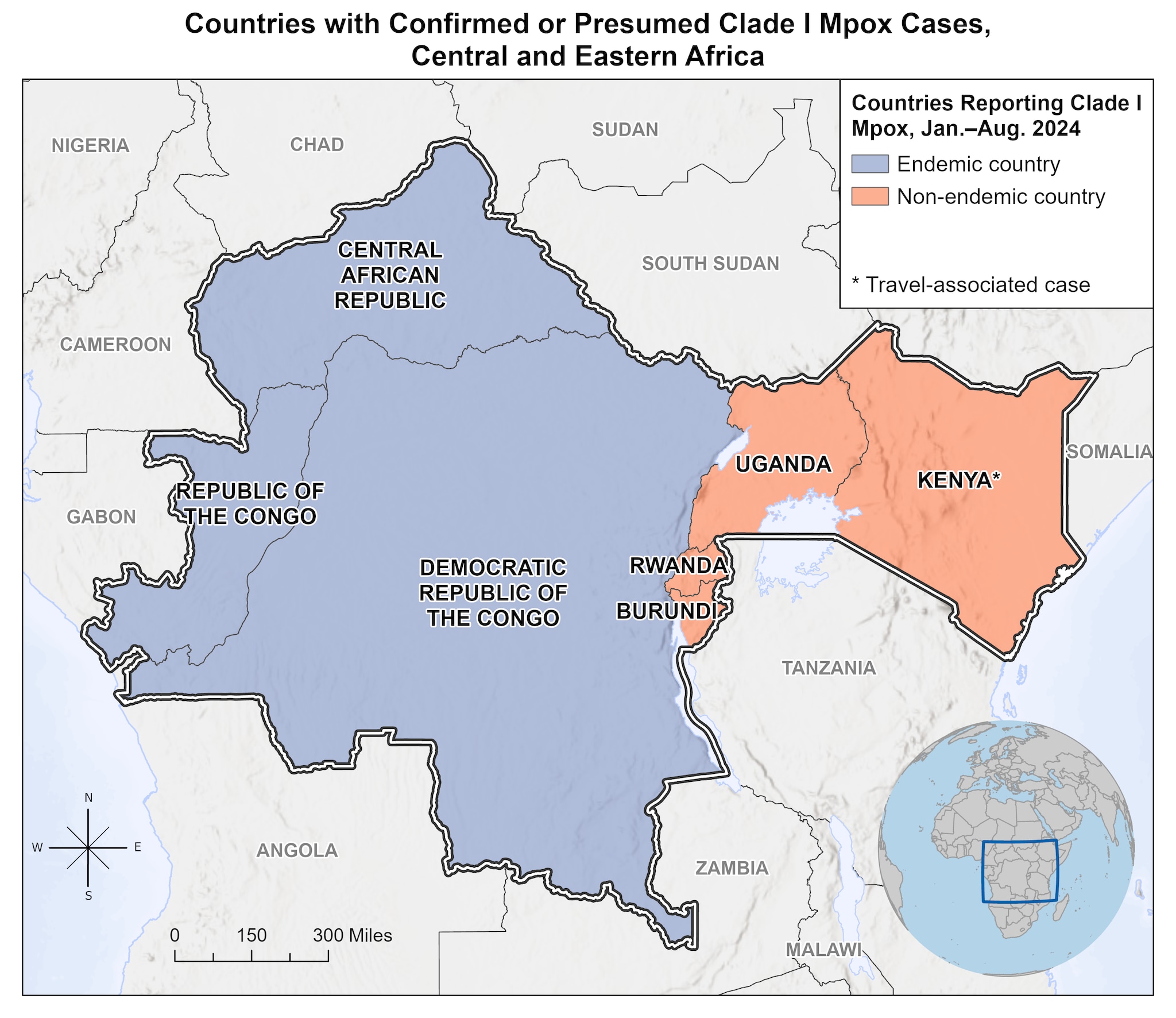What to know
- Since January 1, 2024, the Democratic Republic of the Congo and neighboring countries in Central and Eastern Africa have reported more than 50,000 suspected mpox cases and 1,000 deaths.
- Of these, about 13,000 cases and more than 40 deaths have been confirmed through laboratory testing.
- There have also been travel-associated cases in other parts of Africa, Europe, Asia, and North America.
- The risk of clade I mpox to the public in the U.S. remains low.

Situation summary
In the United States
The first case of clade I mpox in the United States was detected in November 2024, and was related to the outbreak in Central and Eastern Africa. No additional cases were reported.
CDC has assessed the risk to the United States posed by the clade I mpox outbreak in Central and Eastern Africa. The risk to the general population is assessed as low. The current risk to gay, bisexual, and other men who have sex with men (MSM) who have more than one sexual partner, and people who have sex with MSM partners, is assessed as low to moderate. The risk might change as more information becomes available.
CDC mpox prevention recommendations
Learn more about which activities may put you at increased risk of exposure when you travel to a country where clade I MPXV is spreading.
CDC has updated prevention and vaccination recommendations for people traveling to countries with clade I outbreaks. As of January 10, 2024, these countries include Burundi, Central African Republic, Democratic Republic of the Congo, Kenya, Republic of the Congo, Rwanda, and Uganda.
In the Democratic Republic of the Congo
- There are several outbreaks happening at the same time in DRC, with cases reported throughout the country, in the capital city of Kinshasa, and in some other large cities.
- Clade Ia mpox cases are impacting the western part of DRC. Although most cases have not been laboratory-confirmed, available data indicate that clade Ia MPXV is spreading through multiple modes of transmission, including contact with infected dead or live wild animals, household contact often involving crowded households, or sexual contact.
- Clade Ib mpox cases were recently identified in eastern DRC. Available data indicate that these cases are mostly spreading through intimate or sexual contact between adults at first, then spread likely occurs within households, including to children.
More about US and global mpox cases and outbreaks
Learn more about outbreaks of clade I and clade II mpox on the Mpox Current Situation page.
CDC has been supporting DRC mpox research and response for more than 20 years. CDC and other U.S. government agencies are on the ground in DRC helping partners in the country with disease surveillance, laboratory capacity including testing materials, strengthening workforce capacity, case investigation, case management, infection prevention and control, border health, and risk communication and community engagement. DRC has approved the use of vaccines in-country, so CDC is working with other U.S. government agencies and partners on a strategy for vaccination in DRC.
In Central and Eastern Africa

- The bordering countries of Republic of the Congo (ROC) and Central African Republic (CAR), where clade I mpox occurs regularly, experienced clade Ia mpox outbreaks in summer 2024. Some of the cases appear to be linked to spread from DRC.
- In summer and fall 2024, the disease spread to neighboring countries to the east of DRC that are not known to be endemic for the virus that causes mpox, and sustained local spread occurred. These include Burundi, Rwanda, and Uganda. In winter 2024, Kenya began experiencing local human-to-human transmission.
- Person-to-person transmission has occurred during this outbreak, including through sexual contact, household contact, and within healthcare settings, when personal protective equipment was not available.
CDC is working with Ministries of Health and in-country partners across the region on disease surveillance, laboratory capacity including testing materials, strengthening workforce capacity, case investigation, case management, infection prevention and control, border health, and risk communication and community engagement.

Cases reported after travel to areas with clade I outbreaks
- Kenya - July 2024
- Sweden - August 2024; first clade I mpox case to be reported outside of the African continent
- Thailand - August 2024
- India - September 2024
- Germany - October 2024; December 2024 (three additional cases from the same household were reported in December 2024)
- United Kingdom: October 2024 (three additional cases from the same household were reported in November 2024); December 2024.
- Zambia - October 2024
- Zimbabwe - November 2024
- United States - November 2024
- Canada - November 2024
- Belgium - December 2024
- Oman - December 2024
- Pakistan - December 2024
- France - January 2025
- China - January 2025
A single person with mpox is not cause for widespread concern, since public health authorities can quickly identify, isolate, and treat the person or family, and the risk of spread to other people and households can be minimized. Rapid response measures, such as contact tracing and vaccination, can effectively contain disease in these situations.
Notes: Case data reported in humans to WHO since January 1, 2024, are provided for situational awareness and subject to change. Confirmed cases include those laboratory-confirmed as monkeypox virus and may include cases only confirmed as orthopoxvirus. For more information and additional limitations, see WHO-reported data at 2022-24 Mpox (Monkeypox) Outbreak: Global Trends (shinyapps.io).
Source: 2022-24 Mpox Outbreak: Global Trends. Geneva: World Health Organization, 2024. Available online: https://worldhealthorg.shinyapps.io/mpx_global/ (last cited: August 27, 2024)
